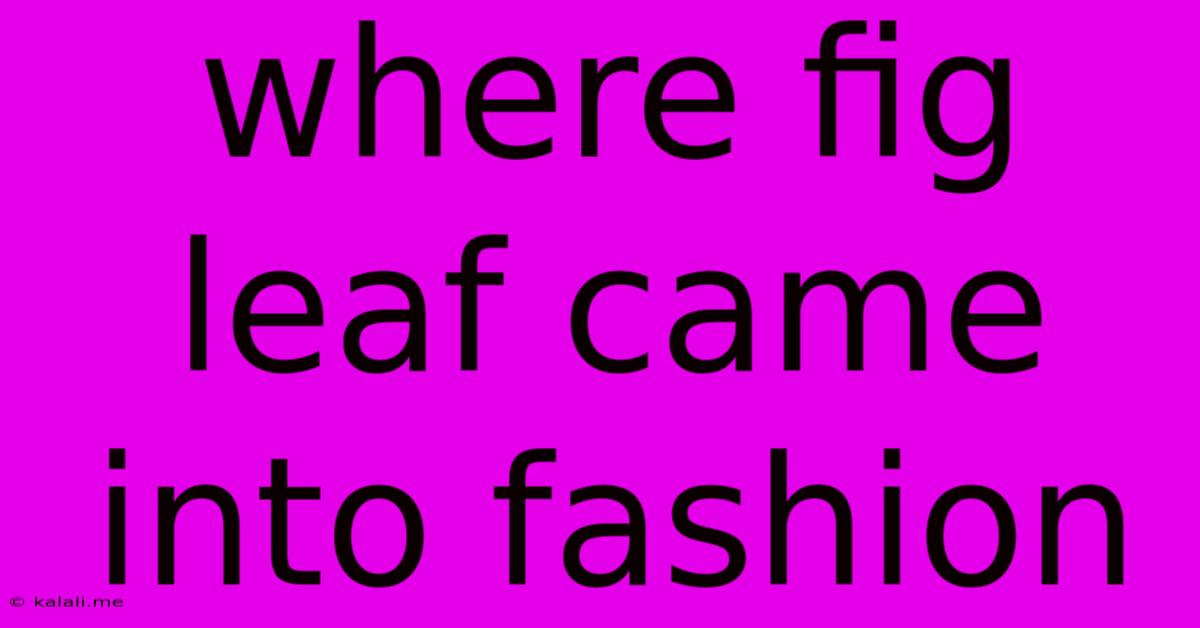Where Fig Leaf Came Into Fashion
Kalali
Jun 08, 2025 · 3 min read

Table of Contents
Where Did the Fig Leaf Come Into Fashion? A Look at History and Symbolism
The fig leaf, that instantly recognizable symbol of modesty and concealment, holds a surprisingly rich history. Far from being a simple fashion choice, its use has evolved through religious, artistic, and cultural contexts, becoming a powerful visual metaphor. This article delves into the intriguing origins and enduring significance of the fig leaf in fashion and art.
The most famous depiction of the fig leaf comes from the biblical story of Adam and Eve in the Garden of Eden. After their transgression, they realize their nakedness and use fig leaves to cover themselves. This narrative, ingrained in Western consciousness, firmly established the fig leaf as a symbol of shame and the loss of innocence. However, the story itself doesn't define the origin of fig leaf usage; it rather solidifies its existing symbolic power. The use of fig leaves for covering likely predates this biblical account.
Pre-Biblical Use: Practicality and Symbolism
Archaeological evidence and anthropological studies suggest that the use of leaves, including fig leaves, for covering was a practical necessity in early human societies. Before the advent of textiles, readily available leaves provided a rudimentary form of clothing, offering protection from the elements and perhaps a degree of modesty depending on cultural norms. The fig leaf, with its large size and readily available nature in warm climates, likely became a prominent choice.
It's important to differentiate between simple bodily covering and the symbolic use of the fig leaf. While the practical application existed long before the biblical narrative, the Eden story imbued the fig leaf with deeper meaning. It transitioned from a simple covering to a potent symbol representing humanity's awareness of its own mortality and the consequences of transgression.
Artistic Representations and the Fig Leaf's Evolution
The fig leaf's symbolic power is evident in countless artistic representations throughout history. Renaissance and Baroque artists, for instance, often used fig leaves to strategically obscure the genitalia of classical figures, softening the potentially scandalous nudity for a more pious audience. This artistic convention became a standard, transforming the fig leaf into a coded language communicating both modesty and the classical ideal.
Interestingly, the fig leaf's role shifted over time. In some periods, its strategic placement became a subtle form of artistic expression, drawing the viewer's eye to the covered area and enhancing the overall aesthetic impact. The very act of concealing became a way of highlighting.
The Fig Leaf in Modern Culture: Beyond the Biblical Narrative
Today, the fig leaf continues to hold symbolic weight, albeit often used ironically or playfully. It appears in contemporary art, cartoons, and even fashion design, reflecting its persistent presence in our cultural imagination. Its meaning can vary depending on context, ranging from literal modesty to ironic commentary on censorship and societal expectations. The fig leaf transcends its purely practical origins, evolving into a multifaceted symbol capable of conveying a multitude of meanings.
In conclusion, the fig leaf's journey from a practical covering to a potent cultural symbol is a fascinating exploration of human history and the evolution of artistic conventions. Its use didn't begin with the Bible, but rather the biblical narrative cemented its place in our collective consciousness, giving it a lasting power that resonates even today. The fig leaf's story is one of survival, adaptation, and the ever-changing relationship between clothing, culture, and the human body.
Latest Posts
Latest Posts
-
Do Question Marks Go Inside Quotation Marks
Jun 08, 2025
-
How To Take Out Bathroom Fan
Jun 08, 2025
-
Is The Electromagnetic Spectrum Transverse Or Longitudinal
Jun 08, 2025
-
How To Say The Love Of My Life In Spanish
Jun 08, 2025
-
Why Does My Sink Water Smell
Jun 08, 2025
Related Post
Thank you for visiting our website which covers about Where Fig Leaf Came Into Fashion . We hope the information provided has been useful to you. Feel free to contact us if you have any questions or need further assistance. See you next time and don't miss to bookmark.